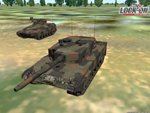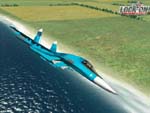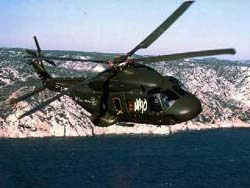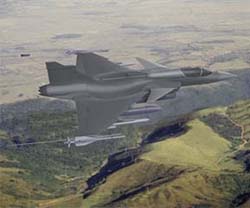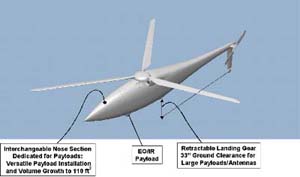Page 1
Daily News
By Gail Helmer
| Send Us News | Archives | Main |
Friday February 01, 2002
PC News
- New Screens: Lock On: Modern Air Combat
- New Screens: Jane's Attack Squadron
- Global Operations Intro Movie
- Northrop Grumman Delivers 100th Super Hornet Shipset
- Laughlin T-37 Crashes
- Saab Wins Helicopter Contract Worth SEK 2 Billion
- Gripen Responds To Australia Air 6000 RFI
- A160 Hummingbird UAV Conducts First Forward Flight
New Screens: Lock On: Modern Air Combat
Ubi Soft has released 2 new screens of the upcoming jet simulation Lock On: Modern Air Combat.
Lock On: Modern Air Combat combines a broad scope of game play that includes a dynamic battle generator, an immersive combat environment, and in-your-face action. Choose from eight U.S. and Russian jets that range from the tank-killing A-10 Warthog and, ground-pounding Su-25 Frogfoot to air superiority fighters like the F-15C Eagle and Su-27 Flanker. Filled with intense campaigns, realistic flight modeling and flexible game options, Lock On will provide unlimited game play action to both novice and veteran flight sim fans.
New Screens: Jane's Attack Squadron
Xicat Interactive has sent us new screens of the upcoming jet simulation Jane's Attack Squadron. Jane's Attack Squadron is being developed by Mad Doc Software (a team that includes part of the original team at Looking Glass Studios). JAS is based in WWII's Western European Theater and will feature 14 flyable aircraft, including fighter-bombers, such as the American P-38 and the German Fw-190, and some medium and heavy bombers, including the American B-17 and the German Ju-88. Jane's Attack Squadron is expected to be released March 2002.
Global Operations Intro Movie
German site Giga.de has posted the intro movie for Global Operations. Global Operations will feature team-based action in 16 different real-world locations, including Peru, Sri Lanka, Mexico, Ireland, and the South China Seas. The game will include more than 30 types of realistic weapons and a variety of equipment, such as body armor, night-vision goggles, binoculars, and medical kits. Release Date: Early 2002.
Military News
Northrop Grumman Delivers 100th Super Hornet Shipset
Northrop Grumman's Integrated Systems sector, the principal F/A-18 subcontractor to prime contractor Boeing, has delivered the 100th centre/aft fuselage section for the F/A-18E/F Super Hornet, the US Navy's newest tactical fighter.
Northrop produces the Super Hornet's centre and aft fuselage, twin vertical tails and integrates all associated subsystems at its Air Combat Systems facility in El Segundo. These F/A-18 "shipsets" are delivered to Boeing's Military Aircraft and Missile Systems facility in St. Louis for final assembly.
Including the newest E/F model, Northrop Grumman has delivered a total of 1,579 shipsets since the F/A-18 programme began in the 1970s. The F/A-18C/D model has seen extensive action in Afghanistan as part of Operation Enduring Freedom, and the Super Hornet is scheduled for its first operational deployment this year.
The E/F has been in production since 1994 and features improved power, greater range and weapons capability and advanced avionics. The Navy plans to buy a minimum of 548 Super Hornets through 2010.
Northrop Grumman, which delivered its first Super Hornet shipset in 1998, performs its work under a $3.16 billion multiyear procurement contract for 222 shipsets awarded by Boeing in 2000. Current production rate is 4.5 shipsets per month.
Laughlin T-37 Crashes
A T-37 Tweet trainer aircraft assigned to the 47th Flying Training Wing here crashed at about 1:30 p.m. CST on Jan. 31 killing the instructor pilot and student onboard. Their identities are being withheld pending notification of next of kin. The aircraft went down near the base’s auxiliary airfield in Spofford, Texas. A board of officers will investigate the accident. More information will be released as it becomes available.
Saab Wins Helicopter Contract Worth SEK 2 Billion
Saab and NHIndustries have signed a contract for the development and production of a tactical mission system (TMS) for the new Swedish multi-role helicopter, the NH90, at a value of around SEK 2 billion. In addition to this initial order, the Swedish helicopter deal will entail further business opportunities for Saab of a similar scope.
"This contract is the result of the broad expertise that exists within the Saab Group. This is creating new business opportunities, and we have also strengthened our position as a qualified supplier and business partner to yet another major international supplier of defence materiel," says Bengt Halse, President and CEO of Saab AB.
When the Nordic Standard Helicopter Programme (NSHP) decided in September last year to purchase NH90 helicopters, NHIndustries entered into final negotiations with Saab for the development and production of a TMS for the Swedish multi-role helicopter. The contract with In addition to this contract, NHIndustries has an extensive offset commitment in relation to Sweden, where Saab can expect to obtain further business of the same volume. This offset commitment lasts until 2009.
Saab will be have systems responsibility for developing the TMS, including development, production and integration of systems computers, digital maps, registration equipment, AIS transponders, as well as the acquisition of tactical radar. The undertaking also includes ground-based evaluation and planning equipment from Saab. In addition, a new mission and anti-submarine warfare system will be developed as part of the TMS. This will become an important part of the Swedish Armed Forces' future structure and management philosophy in order to meet the demands as regards fitting into the new network-based defence.
At the same time, a separate contract has been signed whereby Saab will produce 200 forward fuselage for the NH90. This is equivalent to around two-thirds of the total number of helicopters ordered to date for Germany, France, Italy, the Netherlands, Portugal and now also for Sweden, Norway and Finland.
In total, the Swedish Defence Mat‚riel Administration has ordered 18 NH90s, with the first delivery being made in 2005 and the final delivery in 2009.
Gripen Responds To Australia Air 6000 RFI
Gripen International has submitted a response to the Australian government's Request For Information (RFI) for its Air 6000 project, 'New aerospace combat capability'. Australia issued the RFI last year, for technical information about the Gripen swing-role fighter to meet its national defence needs from 2012 and beyond. Gripen International has submitted technical information based on the supply of the JAS 39 Gripen and its future enhancements.
"We are confident that with planned technology developments the Gripen is ideally suited to play a significant role in Australia's future Air Force and would fit perfectly into a network centric warfare structure interoperating with unmanned combat air vehicles", says Ian McNamee, Managing Director Gripen International.
Computer generated image of future Gripen.
Gripen is the first fourth-generation multi-role fighter in service world-wide, designed to meet the demands of all current and future threats, while at the same time meeting strict peace-time requirements for flight safety, reliability, training efficiency and low operating costs.
Already in service with the Swedish Air Force, which has ordered 204 aircraft (including 28 dual-seaters), Gripen has also been ordered by the South African Air Force (28 aircraft) and Hungary has signed an agreement with the Swedish government for the lease of 14 Gripen fighters. Gripen has also recently been selected to meet the national, NATO and European defense needs of the Czech Republic, which has a requirement for 24 fighters.
Gripen International has begun negotiations with the Polish government, which is looking to procure up to 60 new fighters. An offer has been submitted to the Brazilian government based on the supply of 24 new Gripen and to the Austrian government, which has a requirement for up to 30 new Gripen.
Gripen International is equally owned by Saab of Sweden and BAE SYSTEMS of the UK.
A160 Hummingbird UAV Conducts First Forward Flight
On January 29, 2002, the Defense Advanced Research Projects Agency (DARPA)/ Frontier Systems In Hummingbird A160 vertical takeoff and landing unmanned aerial vehicle successfully conducted its first forward flight at the Southern California Logistics Airport, Victorville, Calif. All flight systems, including avionics, flight control, power plant and drive train, fuel systems, electrical power generation, data link and telemetry performed completely as planned.
The Hummingbird lifted off the tarmac in autonomous mode and climbed to a hover 50 feet above the ground for several minutes. The A160 then retracted its landing gear and executed test manoeuvres including forward and backward flight, right and left slides and heading manoeuvres.
Following the hover sequence, Hummingbird transitioned into autonomous forward flight, climbing to 4,000 feet above mean sea level (1,200 feet above ground level). The air vehicle reached and sustained a speed of 45 knots during the majority of forward flight. Flying autonomously, the A160 travelled several miles away from the ground control station. During flight, the Hummingbird maintained 80 percent of maximum rotor RPM using the patented variable speed rotor that is the focus for DARPA's Hummingbird program.
The Hummingbird concluded the flight by returning to the landing area and descending vertically to a gentle landing. The landing was conducted under operator-guided control. The flight lasted 20 minutes, limited by deteriorating weather.
DARPA programme manager Art Morrish noted, "This flight was the culmination of many months of work by the Hummingbird government-industry team. I'm very pleased with this success and I look forward to additional flights over the coming months. The Hummingbird technology is going to bring the military a revolutionary new capability for rotorcraft and I expect to demonstrate this through our flight tests."
In preparation for the first forward flight, the Hummingbird A160 had previously demonstrated a brief hover on December 7, 2001.
The programme team will now conduct a thorough analysis of telemetry data gathered during flight, followed by continued flight-testing and envelope expansion.
During the course of the planned 36 months of flight tests, the programme will demonstrate variable RPM flight; completely autonomous flight operations including autonomous takeoff, waypoint navigation, and autonomous landing; and integration of various sensors such as electro-optical/infrared and radar packages. The programme's ultimate goals are to demonstrate these capabilities in conjunction with the overall programme objective of more than 40 hours endurance and a 2,500 nautical mile range with a 300-pound payload.
| Send Us News | Archives | Main |
